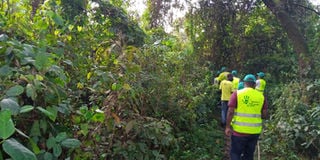Can we have industries and still conserve environment?

Environmentalists under Little Hands Go Green tour part of the disputed Bugoma Forest in Kikuube District last month. PHOTO/EPHRAIM KASOZI.
What you need to know:
- Government maintains that it will pronounce its self on the Murchison Falls issue but environmentalists maintain that conservation must be prioritised while carring out development.
There is raging debate between industrialists and conservationists on whether to construct a hydro power dam on Murchison Falls on the River Nile in Masindi District and clear part of Bugoma Forest in Hoima District to promote industrialisation at the risk of hurting the environment at both places.
On the flip end of the discussion has been the call to outgrow the tradition of keeping natural endowments as conservation hubs in order to pave way for industrial development and job creation.
Commercial projects such as Hoima Sugar, Murchison Falls power dam and wanton logging in Zoka Forest in West Nile have met resistance from environmentalists and other different stakeholders who uphold conservation as a key component of human life and more important than industrialisation.
For instance, environmentalists question the justification for a power dam at the expence of environment when the country already produces excess electricity, which is being exported.
Uganda exports electricity to Kenya, Tanzania and parts of eastern DR Congo. According to a Bank of Uganda report, between January 2019 and January 2020, Uganda exported about 320,372 megawatts, which earned the country Shs$46m (Shs170b).
Mr Tom Butime, the Minister of Tourism, Wildlife and Antiquities, said the discussion on Murchison Falls is a sensitive matter, which has to be balanced against other national development needs.
“Murchison Falls is magnificent and spectacular. One will have to think twice before destroying it. The question of Murchison Falls is a government policy matter. However, specialists say the country needs more power because very soon the current power available will be overtaken.
I have no doubt government will pronounce itself, so for me, there is no cause for alarm,” Mr Butime told Daily Monitor in an interview at the weekend.
Mr Robert Kasande, the Permanent Secretary of Ministry of Energy and Mineral Development, said there are no specifics on how many megawatts the dam will generate or how much revenue the country will earn from it. He said the feasibility study has not been conducted.
Last year, Cabinet approved a bid to conduct a feasibility study to determine the justification of the hydro-power dam at Murchison Falls National Park.
However, government has gone silent about the matter, leaving the public in the dark. Environmentalists want government to give a clear status of the feasibility study.
“Why has government not come out to pronounce itself? This can be a political gimmick now that we are in elections. We need to first pull out of Murchison Falls because it can be contagious in Bunyoro and Acholi. We first pull out without making any public statement,” Mr Solomon Adim, the programme coordinator of Natural Resource Conservation Network, said.
Paying the price
According to environmentalists, tampering with the natural flow of the River Nile water by construction of the dam, will destroy the water falls.
Ms Pauline Nantongo, the executive director of Environmental Conservation Trust Uganda (ECO Trust), said the constructing of a dam will submerge the falls and create an obstacle, which will obstruct the hydrological flow and interfere with the ecology and breeding of fish as well as crocodiles, which are a big tourist attraction at Murchison Falls Park.
“If you dam something, you damage it, you convert it into a lake. That is why the falls would disappear. The dam comes in as an obstacle. You interrupt the ecology of the dam,” she argued.
Experts say animals breed in certain areas such as shallow waters with particular water conditions. They say interrupting the water flow would cause flooding and distort the depth required for fish to lay eggs for breeding.
Mr Edison Nuwamanya, the chief warden of Murchison Falls Conservation Area, said the construction of the dam will reduce the number of tourist visits by 100,000 annually. He says before Covid-19 broke out, tourism at the conservation centre was growing at 13 per cent per year. He adds that the park earns Shs12 billion in tourist revenue per year.
Mr Matthias Schauer, the German ambassador to Uganda, warns that the country will pay a high economic price if conservation is tampered with.
“Conservation is not just nice to have. It is not for people who like sitting under the trees, this is about our livelihoods,” Mr Schauer said.
The conflict between the environment and industrialisation is not restricted to Murchison Falls. The National Forestry Authority (NFA), environmentalists and Hoima Sugar are engaged in protracted court battles over land utilisation of Bugoma Forest in Hoima District.
Mr Tom Okello, the NFA executive director, said sugarcane planting by Hoima Sugar Company will degrade Bugoma Forest and hurt the tourism sector.
“We expect Bugoma to play a very big role in harnessing oil in this region. Bugoma is one of the areas that will be absorbing carbon, which is associated with oil exploitation,” Mr Okello said.
“There is a research station inside the forest. We are also trying to habituate chimpanzees for tourism purposes. ,” Mr Okello said.
Mr Per Lindgarde, the Swedish ambassador to Uganda, said forests are tourist attractions and preserve environment but are also good for biodiversity conservation, which is part of the globe’s sustainable development goals.
Ms Beatrice Anywar, the State Minister for Environment, said government will reopen the forest’s boundaries to know the extent of the encroachment.
Revenue
In 2018/2019 Financial Year, the tourism sector accounted for at least 7.7 per cent of the country’s GDP and 6.7 per cent of total national employment after creating 667,600 jobs.
UWA says at least Shs90b is received from wildlife-based tourism.





